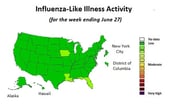A new U.S. Supreme Court ruling may increase the odds that most of the Affordable Care Act (ACA) will still intact, even if the court declares the individual health coverage mandate provision to be unconstitutional.
The court raised that possibility in a new ruling on Barr v. American Association of Political Consultants Inc. (AAPC) (Case Number 19-631), a case that deals with whether robocall systems trying to collect amounts owed to the Internal Revenue Service and other federal agencies can have more access to people’s cell phones than robocall systems working for political parties.
The federal Telephone Consumer Protection Act (TCPA) normally restricts organizations’ ability to use robocall systems to call people’s cell phones. A 2015 TCPA amendment would have created an exception for robocall systems seeking to collect debts owed to or guaranteed by the United States.
The court held Monday, in a 7-2 decision, that the TCPA amendment is unconstitutional, under the First Amendment of the U.S. Constitution, because it gives debt collection speech a higher priority than political speech.
Resources
- A copy of the Barr v. AAPC opinion is available here.
- An article about how the Supreme Court justices talked about severability in another recent ruling is available here.
For agents, brokers and others interested in the ACA, the key part of the majority opinion in the Barr v. AAPC case deals with what happens when the federal courts find that one part of a long federal law is unconstitutional, or otherwise invalid.
The Affordable Care Act Severability Fight
The ACA is made of up two separate federal statutes: the Patient Protection and Affordable Care Act of 2010 (PPACA) and the Health Care and Education Reconciliation Act of 2010 (HCERA).
One part of PPACA, the “individual shared responsibility” provision, requires many people to have what the federal government classifies as a minimum level of major medical health coverage or else pay a penalty.
Other parts of PPACA have:
- Required many employers to provide a minimum level of health coverage, or else pay a penalty.
- Restricted health insurers’ ability to use medical underwriting.
- Set minimum major medical insurance benefits standards.
- Set up the ACA health insurance exchange program.
- Created subsidy programs meant to protect health insurers against the effects of all of the new rules, including the ACA tax credit subsidy program for ACA exchange plan coverage.
- Created the Summary of Benefits and Coverage “milk carton labels” for major medical insurance policies.
- Provided funding for the ACA Medicaid expansion program, medical professional education programs, pandemic preparedness programs, and programs meant to help health care providers understand how to treat older patients.
- Required the government to do more to help older people and young people with disabilities stay in the community.
- Phased out the Medicare Part D prescription drug coverage “donut hole,” or the gap between when routine benefits end and catastrophic benefits start.
ACA supporters argued, in a case the U.S. Supreme Court decided in 2012, that the individual mandate penalty was constitutional and was essential to the ACA.
The court ruled that the individual mandate penalty was a tax and that, therefore, plaintiffs were unable to challenge the constitutionality of the mandate provision, due to a federal law that keep people from suing to block new federal taxes.
Congress set the individual penalty at zero in 2017.
Officials in Texas and other states that generally oppose the ACA have argued that, now that the penalty has been set at zero, the provision is no longer a tax and is simply an unconstitutional requirement for people to buy a commercial product.









 July 07, 2020 at 01:10 PM
July 07, 2020 at 01:10 PM











